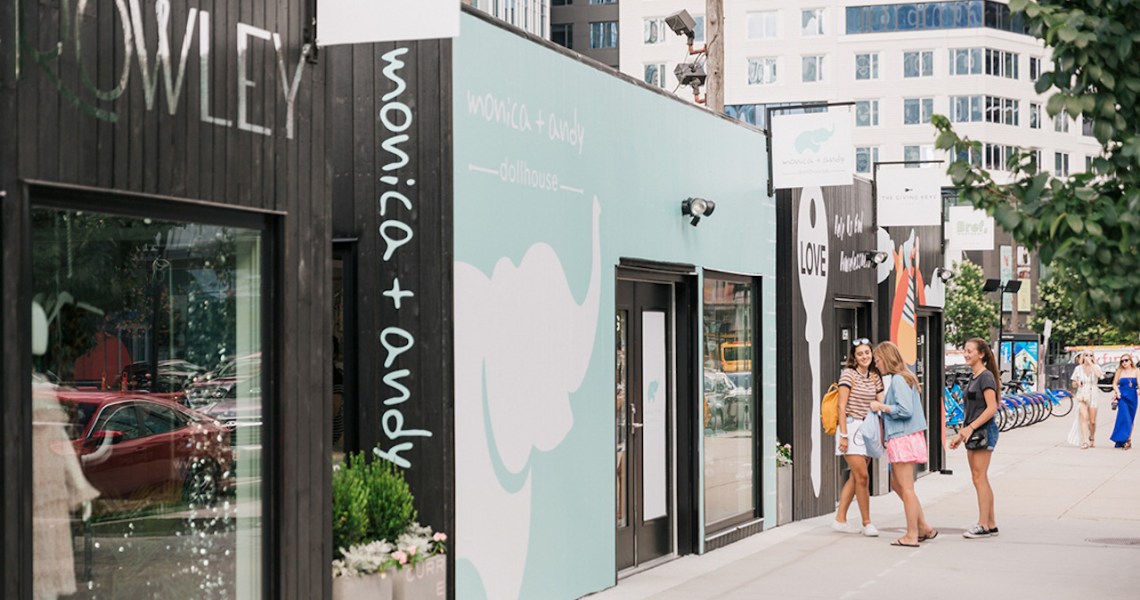Retail’s revival is dependent on more than stores requiring face masks, providing sanitizer and establishing more stringent cleaning guidelines (which they may or may not follow). One-time shopping destinations now need to re-earn their status by offering a vibrant experience, within reason.
In the early phases of reopening, landlords, developers and retailers have been busy filling the many new vacancies, leaning into traffic drivers like restaurants and thinking outside the box to ensure shoppers’ visits are not only comfortable, but also worth the trip. Along with putting these centers on a path to growth, a goal is to make shoppers overlook the sad state they were in after being forced to close for months.
“With our on-site team, it’s a constant conversation of: What’s the level of entertaining our guests that we can provide, without it becoming an event or creating a crowd and an unsafe environment?” said Stenn Parton, chief retail officer at developer DJM, which manages open-air malls in Southern California and Texas.
Retailers know they have work to do to bounce back, as American consumers have become more comfortable with shopping online.
To attract more visitors, Parton said DJM secured permission from the local governments of its mall properties to expand patio spaces outside of restaurants, allowing for more outdoor seating and social distancing. It also set up seating in restaurant-adjacent streets and parking lots.
Across DJM’s properties, which include Lido Marina Village in Newport Beach and Legacy West Urban Village in Plano, Texas, foot traffic is currently at 80-90% of where it was last year. Both malls remain open, despite recent surges in coronavirus cases. The main driver is the outdoor patio spaces, he said. For the week of June 14, fashion retailer LoveShackFancy saw in-store sales at Lido Marino Village that topped pre-pandemic projections.
Meanwhile at Boston Seaport, retailers including Bonobos have moved clothing racks outside of their shops for makeshift sidewalk sales in the name of making customers comfortable, said Todd Norley, vp of leasing at WS Development.
Ad position: web_incontent_pos1
“Moving forward, public space and outdoor space are going to be king,” said Parton, adding that DJM just added an acre of public space to a mall property that’s mid-construction.
But getting the most out of those large spaces will be a challenge for a while. In a typical year, DJM’s properties host more than 1,200 events that are attended by more than 30 million visitors who stay and shop. For at least the next six months, the company is instead providing “ambient” or “passive” entertainment, like people playing soft music, said Parton.
On the same note, most landlords that have lost long-term leases need to make do.
“Retail experts call vacancies ‘missing teeth,’” said Carrie Denning Jackson, who heads up ground-floor innovation and development at Alphabet’s urban development company, Sidewalk Labs. “They make blocks less exciting, they depress street life activity and they depress property values and rents. And right now, getting neighborhoods active and exciting again are really important.”
On Tuesday, along with pop-up real estate agency Wallplay, Sidewalk Labs released what they’re calling the Ground Floor Pop-Up Toolkit. The manual, which is available to download on both companies’ websites, is intended to help landlords and retailers on their path to recovery by guiding them through mutually beneficial and less costly pop-up agreements. Both companies will promote the guide via digital ads following Fourth of July weekend.
Ad position: web_incontent_pos2
Denning Jackson said short-term leases are the way forward, as they add freshness and variety to a block — and, more importantly, they provide the landlord with immediate revenue. In addition, they open doors for entrepreneurs, traditionally disadvantaged tenants, and people who don’t have the high credit or the years of operating history needed to secure a long-term lease.
For its part, to quickly fill vacancies left by stores and restaurants that were forced to close since March, DJM offered spaces to brands on a profit or percentage rent basis for the remainder of the year.
“For the last few years, it’s been a trying time for the retail sector,” said Parton. “But [the pandemic] has served as applied pressure, forcing it to bend in a way that it has never been bent before.”




